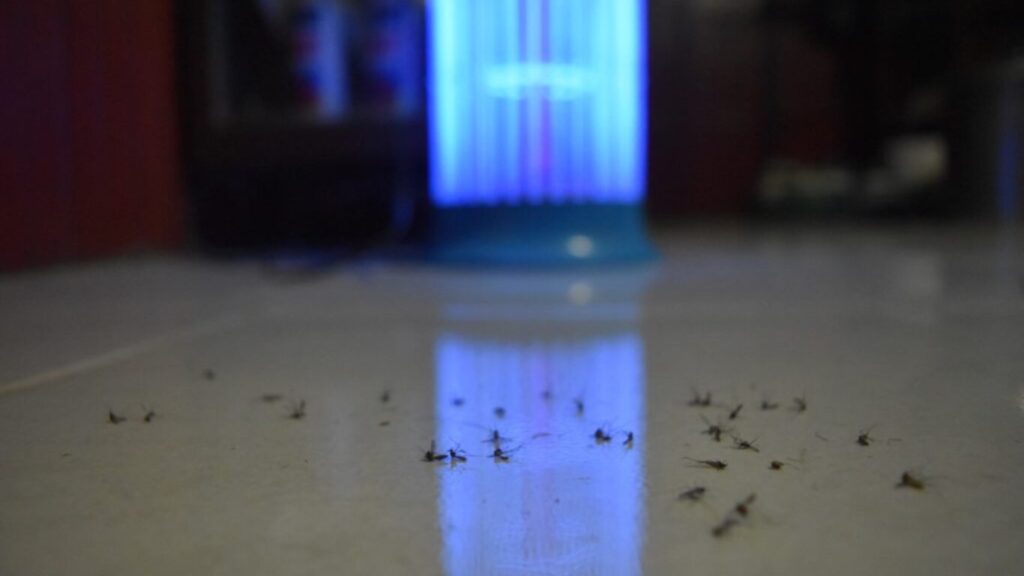We all are familiar with the scene: a hot summer evening, a soft glow emanating from a porch light and the endless buzz of insects flocking to its light. For many, this can be a considerable nuisance, which explains the trendy pastime of using orangey bulbs as a deterrent to such invaders. So how well do orange lights actually repel bugs? And is there a more effective method, such as the use of blue lights? That’s what we are focusing on, today as we use the question “do blue lights keep bugs away?” as our vehicle.
| Light Color | Visibility to Bugs | Attractiveness |
|---|---|---|
| Blue | High | High |
| White | High | High |
| Yellow | Low | Low |
| Red | Low | Very Low |
| Green | Moderate | Moderate |
How Insects See and the Importance of Light

To understand why some lights may repel bugs, we need to understand how bugs see light. Unlike humans, with their widely-multiplexed retinas, insects view the world through compound eyes that are incredibly sensitive to different wavelengths of light.
Insects are commonly attracted to shorter-wavelength light (UV/blue). Some insects are, however, less attracted to the long wavelenghts, yellow and orange. One reason people think that changing the color of their lights will change the number of insects attracted is the difference in attraction.
The Urban Legend of Orange Lights and Bug Repellency

Common theory: that orange lights repel insects. The primary reason for this perception is the fact that orange light does not attract insects as much as blue light does. But is there some truth to this?
Studies have indicated that orange lights potentially attract fewer insects than regular lighting but do not repel insects proactively. Insects are also drawn to things like carbon dioxide, moisture, and heat, unaffected by the color of your light.
You may also read (betwee appliances broom)
How Blue Lights Work to Control Insects
Blue light has also received interest as a candidate for insect control. Note that blue light specifically (400-500 nm) has been identified as lethal to insects.
Blue light impacts several insects, including fruit flies, mosquitoes and flour beetles, studies show. It can have deadly effects on mosquito larvae and pupae and can also interfere with insect development and behavior. In addition, blue light can be used to attract only harmful insects while leaving the natural predator species unaffected.
Light blue vs. Light orange: A Description
- Shedding light on blue and orange light in insect control
- There are benefits to blue light:
It leads to greater insect mortality rates.
- It targets certain insect developmental stages.
- However, there are also disadvantages to blue light:
It may adversely affect non-target organisms.
- It consumes more energy.
When considering cost-effectiveness, there are many factors involved, primarily the type of insect problem and the location of said insect problem.
The Market for Blue Light Insect Traps

Its use for pest control is reported in agricultural fields, food processing facilities, and residential areas. It can also work alongside other pest control strategies. But it’s necessary to use appropriate light intensity and exposure times and to take into account safety for humans and pets.
Tackling Issues and Calling Challenges
Blue light for pest control may have adverse effects on non-target species, high energy consumption, and contribution to light pollution.
These limitations can be alleviated by careful positioning of light traps, using low intensity light sources, as well as combining with other pest control mechanisms. Buffer — Regulatory Considerations for Blue Light for Pest Control
Research and Evolution.
However, various avenue for study remains, including optimizing blue light wavelengths for various pest species, designing less energy-intensive blue light technologies and redacting how long effects persist on landscapes. Blue light pest control continues to evolve, paving the way for more effective and eco-friendly solutions.
Conclusion
To sum up, orange lights may attract fewer insects than traditional lights do, but they do not work to repel insects. Blue lights, however, have shown promise as an effective and selective method for pest control. But, their environmental cost and responsible usage is important consideration. But ongoing research and implementation will be key to ensuring that the future of pest control is indeed bright designed in blue.
You may also read (what is the best way to clean a stainless steel hob)

